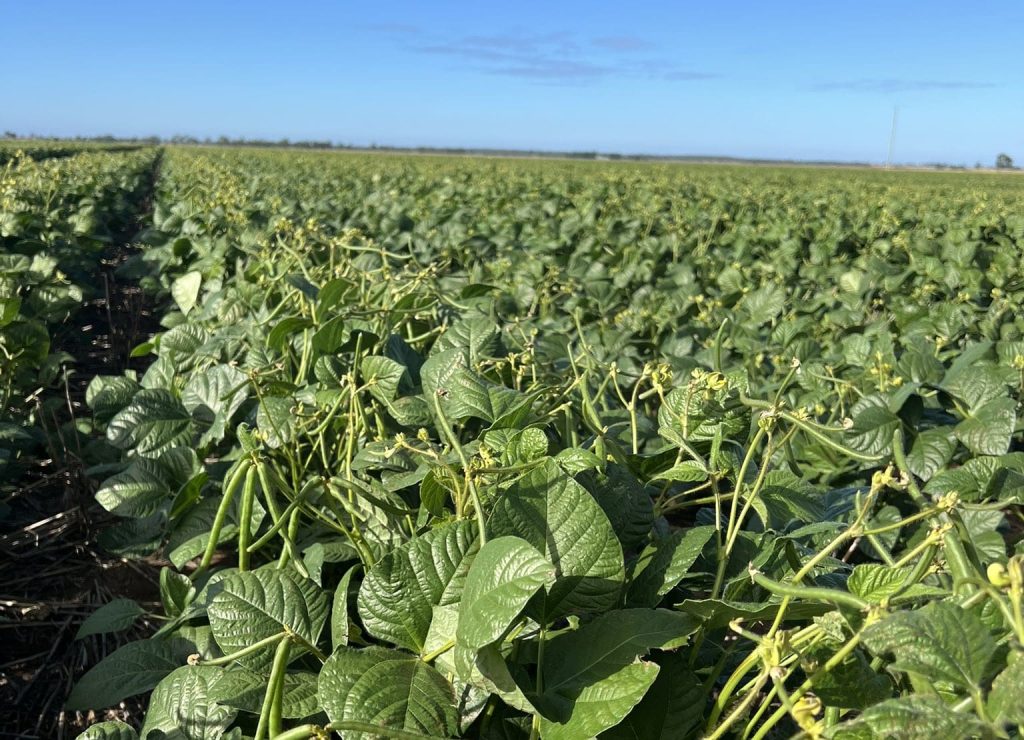
An impressive mungbean crop growing on Qld’s Darling Downs. Photo: Lance Wise
GROWERS are hopeful Tropical Cyclone Alfred will deliver the rainfall required to support the potential of the 2024-25 mungbean crop.
Most mungbean crops in Queensland and New South Wales need decent falls to sustain quality and yield.
Industry has estimated the 2024-25 mungbean area at 130,000-150,000ha, with planting still under way in some parts of Central Qld.
Harvesting has begun on small areas throughout Qld and New South Wales, with positive results reported from these crops.
However, for most growers, the arrival of rain from Tropical Cyclone Alfred, expected to reach south-east Qld tomorrow, will offer a much-needed boost to crop growth.
The Bureau of Meteorology has Alfred at a category 1 cyclone, expected to intensify to a category 2 as it approaches the coastline.
Forecasts predict 50-100mm of rain for parts of southern and western Qld over the next five days, with slightly lower totals expected in northern NSW.
Australian Mungbean Association president James Hunt said this weather event would be ideal to shore up the mungbean crop into harvest.
“The majority of the crop grew to a very good vegetative stage but is in despite need of a drink,” Mr Hunt said.
“A drink of rain off the back of this cyclone will see a really good crop in a high demand year.”
He said that despite the drier conditions, the small volume of harvested crops was “looking pretty good.”
“Some of the growers have said that the crops are a little premature because of the dry finish, and they are coming in quickly.”
Independent agronomist Paul McIntosh said there was a wide range of growth stages across both states.
He said earlier crops, planted from November, were suffering due to the lack of consistent rainfall in January and February.
Mr McIntosh said this was the experience throughout most growing regions from Central Highlands in Qld to the Liverpool Plains in NSW.
“It’s a mixed bag, but, in general, apart from people harvesting their earlier ones, their later crop could do with some rain,” Mr McIntosh said.
In NSW, patchy rainfall and staggered planting have resulted in a wide range of crop conditions.
Mr McIntosh said overall the NSW was planted later compared to previous seasons, primarily in January.
“East of [Gunnedah] is pretty dry and some of the crops are going to go back to livestock feed…and other crops to the west of Gunnedah are quite good.
“Up to Narrabri there is a mixed bag, depending on if you got the rain or not.
“In Moree and east of Moree to Croppa Creek and North Star, there’s some handy crops already of mungbeans and there’s going to be some more…that have only been planted in the last two to three weeks.”
Mr McIntosh said this experience was replicated in the Darling Downs, with most crops in need of significant rainfall.

Paul McIntosh checking out a thriving crop of Opal mungbeans in central NSW.
Strong CQ late plant
After a dry end to 2024 and early 2025, there was little early-planted mungbeans in the Central Highlands and Callide-Dawson regions.
Mr McIntosh said positive February rainfall spurred late crops in these regions with a “pretty major” plant predicted.
“The Central Highlands have had some later rain events.
“Two or three weeks ago, they were very dry, so there will be a large area of mungbeans that has gone in and going in still to the Central Highlands.
“Callide-Dawson had much the same sort of rain event as the Central Highlands and they’ve got quite an area in and around the Callide-Dawson, below Moura and Theodore.”
Price supports interest
Mr Hunt said the AMA was pleased with the area planted to mungbeans, and ongoing grower interest in the crop.
He said, while extended periods of back-to-back sorghum crops supported growers’ switch to mungbeans, the strong prices was also an “extra incentive”.
“Growers are seeing very good prices, even for the lower grade of manufacturing.”
Mr Hunt said this was in the range of $1100-1200 per tonne on a hectare-contract basis.
At this stage and if minimal flooding is recorded from Tropical Cyclone Alfred, industry predicts the majority of the 2025-26 crop will be harvested in April.
Grain Central: Get our free news straight to your inbox – Click here